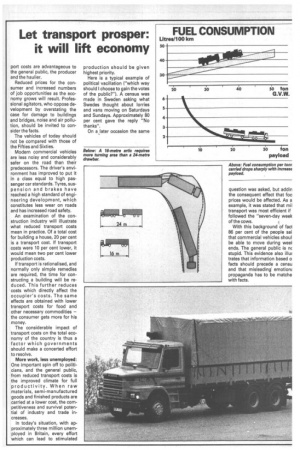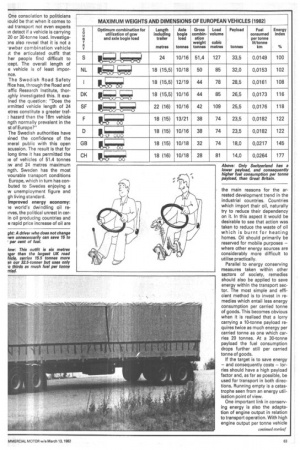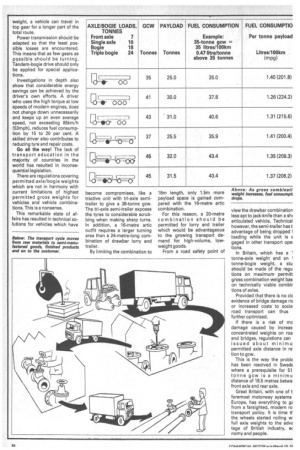Let transport prosper: it will lift economy
Page 57

Page 58

Page 59

Page 60

If you've noticed an error in this article please click here to report it so we can fix it.
The UK needs an increase in gross combination weight and there is plenty of evidence in Europe to show that a single drive axle is sufficient. Sven Nylin argues this case . . .
EFFICIENT ROAD TRANSPORT contributes to improved competitiveness for rail and sea transport. It is through co-operation that the total transport capabilities of a country can be optimised economically; this is not accomplished through strangling competition via legislation.
Great Britain is the last country but one in Europe to properly utilise the payload capacity of lorries. At last it has started to deliberate an increase of the permitted gross combination weight for commercial vehicles.
But why are the legislators speculating with tying a heavier gross weight to a demand for two drive axles? There is ample evidence available now, without • additional deliberations.
Thisrincludes information gained from more than 20 years' experience of tens of thousands of 40 to 50-tonne heavy vehicle combinations with single-axle drive in Sweden and Holland, and more recently Denmark, Finland, Norway and Italy. The evidence shows that one drive axle with differential lock is completely satisfactory — both with regard to road safety and traction on different types of roads.
Facing such an important decision as raising the gross combination weight of commercial vehicles, any government should strive to obtain optimum return for the improvement — without unnecessary complications.
Experience shows that the effect on the national economy of a gross combination weight increase is important. This applies particularly to Britain where 85 per cent of all goods are carried on roads. From a national economic point of view, an increase of the gross combination weight will produce three advantages.
• It will lower the general cost level and increase Britain's competitive impact on export markets.
• This will in turn improve conditions for production and consequently reduce unemployment.
• Costs will be cut and fuel conserved through reduced fuel consumption per tonne of goods carried and there will be improved energy economy. These claims will be challenged and therefore must be examined.
Lower general cost level: Each cost item for transporting a commodity makes the commodity more expensive. As transporting it does not improve the commodity — sometimes to the contrary — the level of the transport cost affects the final price of the commodity and thereby its competitiveness.
It is difficult to influence the rising cost of energy, labour and other production costs. However, raising the permitted gross combination weight for commercial vehicles can be done, and it will check the rising spiral of costs.
In Britain an increase from the present 32.5-tonne gcw to 40 tonnes constitutes seven to eight tonnes additional payload. The increased payload will be carried at practically unchanged fixed costs. These include capital costs, driver's wages and insurance.
In addition, fuel consumption per tonne drops sharply with increased payload. A considerable reduction in costs per tonne carried results.
Almost every commodity has to travel by road at many stages of its development from raw material to semi-manufactured goods to final product and distribution. The total transport cost constitutes a considerable part of the final price for the commodity.
It follows that reduced trans port costs are advantageous to the general public, the producer and the haulier.
Reduced prices for the consumer and increased numbers of job opportunities as the economy grows will result. Professional agitators, who oppose development by overstating the case for damage to buildings and bridges, noise and air pollution, should be invited to consider the facts.
The vehicles of today should not be compared with those of the Fifties and Sixties.
Modern commercial vehicles are less noisy and considerably safer on the road than their predecessors. The driver's environment has improved to put it in a class equal to high passenger car standards. Tyres, suspension and brakes have reached a high standard of engineering development, which constitutes less wear on roads and has increased road safety.
An examination of the construction industry will illustrate what reduced transport costs mean in practice. Of a total cost for building a house, 20 per cent is a transport cost. If transport costs were 10 per cent lower, it would mean two per cent lower production costs.
If transport is rationalised, and normally only simple remedies are required, the time for constructing a building will be reduced. This further reduces costs which directly affect the occupier's costs. The same effects are obtained with lower transport costs for food and other necessary commodities — the consumer gets more for his money.
The considerable impact of transport costs on the total economy of the country is thus a factor which governments should make a concerted effort to resolve.
More work, less unemployed: One important spin off to politicians, and the general public, from reduced transport costs is the improved climate for full productivity. When raw materials, semi-manufactured goods and finished products are carried at a lower cost, the competitiveness and survival potential of industry and trade increases.
In today's situation, with approximately three million unemployed in Britain, every effort which can lead to stimulated production should be given highest priority.
Here is a typical example of political vacillation ("which way should I choose to gain the votes of the public?"). A census was made in Sweden asking what Swedes thought about lorries and vans moving on Saturdays and Sundays. Approximately 80 per cent gave the reply "No thanks".
On a later occasion the same question was asked, but addin the consequent effect that foe prices would be affected. As a example, it was stated that mil transport was most efficient if followed the "seven-day week of the cows.
With this background of fact 86 per cent of the people sai that commercial vehicles shoul be able to move during weel ends. The general public is nc stupid. This evidence also Mu: trates that information based o facts should precede a censu and that misleading emotion4 propaganda has to be matche with facts.
One consolation to politicians iould be that when it comes to ,ad transport not even experts in detect if a vehicle is carrying 20 or 30-tonne load. Investiga)ns also reveal that it is not a -awbar combination vehicle at the articulated outfit that her people find difficult to :cept. The overall length of e vehicle is of least impornce.
The Swedish Road Safety ffice has, through the Road and .affic Research Institute, thorAghly investigated this. It exained the question: "Does the )rmitted vehicle length of 24 etres constitute a greater traf; hazard than the 18m vehicle ngth normally prevalent in the st of Europe?"
The Swedish authorities have lined the confidence of the moral public with this open scussion. The result is that for long time it has permitted the ;e of vehicles of 51.4 tonnes Nv and 24 metres maximum ngth. Sweden has the most vourable transport conditions Europe, which in turn has conbuted to Swedes enjoying a w unemployment figure and gh living standard.
Improved energy economy:
le world's dwindling oil reirves, the political unrest in cerin oil producing countries and e rapid price increase of oil are the main reasons for the arrested development trend in the industrial countries. Countries which import their oil, naturally try to reduce their dependency on it. In this aspect it would be desirable to see that action was taken to reduce the waste of oil which is burnt for heating homes. Oil should primarily be reserved for mobile purposes where other energy sources are considerably more difficult to utilise practically.
Parallel to energy conserving measures taken within other sectors of society, remedies should also be applied to save energy within the transport sector. The most simple and efficient method is to invest in remedies which entail less energy consumption per carried tonne of goods. This becomes obvious when it is realised that a lorry carrying a 10-tonne payload requires twice as much energy per carried tonne as one which carries 20 tonnes. At a 30-tonne payload the fuel consumption drops further still per carried tonne of goods.
If the target is to save energy and consequently costs lorries should have a high payload factor and, as far as possible, be used for transport in both directions. Running empty is a catastrophe seen from an energy utilisation point of view.
One important link in conserving energy is also the adaptation of engine output in relation to transport operation. With high engine output per tonne vehicle
weight, a vehicle can travel in top gear for a longer part of the total route.
Power transmission should be adapted so that the least possible losses are encountered. This means that as few gears as possible should be turning. Tandem-bogie drive should only be applied for special applications.
Investigations in depth also show that considerable energy savings can be achieved by the driver's own efforts. A driver who uses the high torque at low speeds of modern engines, does not change down unnecessarily and keeps up an even average speed, not exceeding 85km/h (53mph), reduces fuel consumption by 15 to 20 per cent. A skilled driver also contributes to reducing tyre and repair costs.
Go all the way! The lack of transport education in the majority of countries in the world has resulted in inconsequential legislation.
There are regulations covering permitted axle/bogie weights which are not in harmony with current limitations of highest permitted gross weights for vehicles and vehicle combinations. This is a nonsense.
This remarkable state of affairs has resulted in technical solutions for vehicles which have become compromises, like a tractive unit with tri-axle semitrailer to give a 38-tonne gcw. The tri-axle semi-trailer exposes the tyres to considerable scrubbing when making sharp turns. In addition, a 16-metre artic outfit requires a larger turning area than a 24-metre-long combination of drawbar lorry and trailer.
By limiting the combination to 18m length, only 1.5m more payload space is gained compared with the 16-metre artic combination.
For this reason, a 20-metre combination should be permitted for lorry and trailer which would be advantageous to the growing transport demand for high-volume, lowweight goods.
From a road safety point of view the drawbar combination less apt to jack-knife than a shi articulated vehicle. Technical however, the semi-trailer has t advantage of being dropped 1 loading while the unit is gaged in other transport opel tions.
In Britain, which has a tonne-axle weight and an tonne-bogie weight, a stu should be made of the regu tions on maximum permitt gross combination weight bas on technically viable combir tions of axles.
Provided that there is no cis evidence of bridge damage ris or increased costs to socie road transport can thus further optimised.
If there is a risk of mc damage caused by increas concentrated weights on roa and bridges, regulations can issued about minimu permitted axle distance in re tion to gcw.
This is the way the proble has been resolved in Swede where a prerequisite for 51 tonne gcw is a minimu distance of 18.5 metres betwe front axle and rear axle.
Great Britain, with one of t foremost motorway systems Europe, has everything to gE from a farsighted, modern ro transport policy. It is time th the wheels started rolling w full axle weights to the advz tage of British industry, er nomy and people.


































































